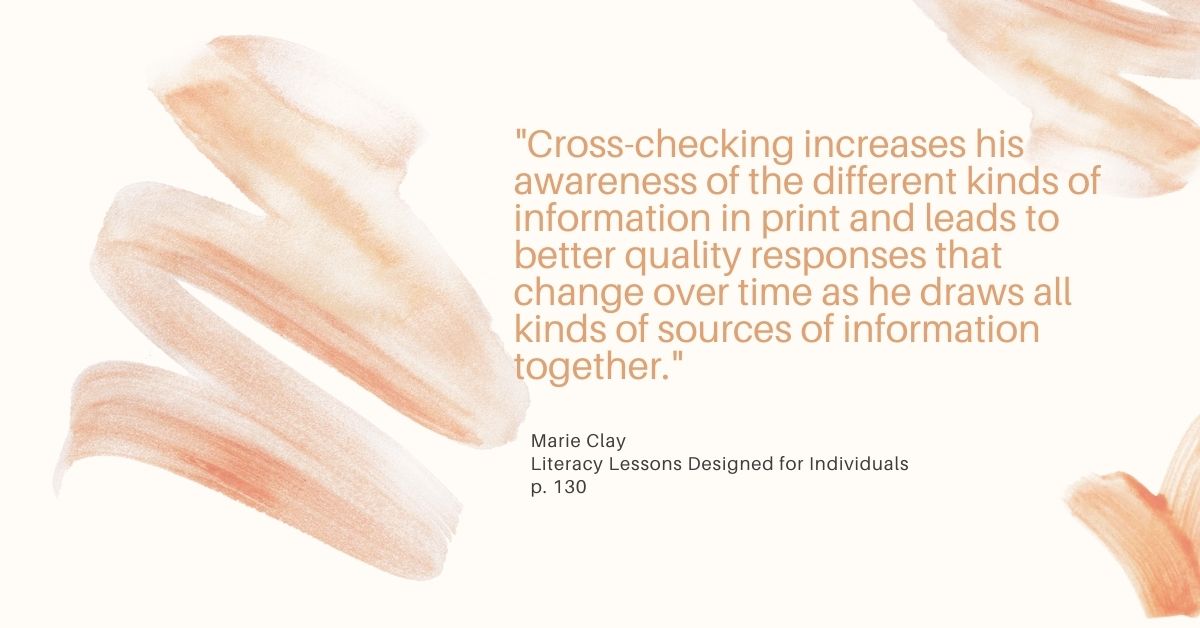Literacy Pages: The Series presents the fifth post in an 8-post series related to Reading Recovery and Teaching with Discontinuation in Mind from Early Lessons.
Cross-checking is the behavior in which a student checks one or more sources of information against each other. The act of cross-checking can lead to a self-correction in which all of the sources of information match with what is written on the page.
In order for children to demonstrate cross-checking behaviors, they will need to be able to monitor their reading and know how to search in a coordinated manner.

Signs of Cross-checking
Cross-checking is an early behavior in which we need to watch for and reinforce early in our lessons. Early signs of cross-checking behaviors can be seen when the student:
- rereads because the number of words did not match his finger
- starts to make self-corrections
- makes an indication that he is not content with the reading
- begins to check the visual information against meaning and structure.
Be tentative & flexible
When teaching for cross-checking we want to take note of what sources of information a child is using and what they are neglecting. We will teach the child how to cross-check with the source(s) they are neglecting. Since reading is an in the head process it is important to stay tentative and flexible with our assumptions because we can never be completely sure of the processing that is happening in the brain.
Strong oral language can interfere with linking the oral reading to the visual forms. We may need to assist the child in recognizing what is known by having the child find known words on the page and then rereading the page. We can explicitly show students how to check what they neglected with what information they used. We can analyze our students’ reading behaviors, as shown on their running record, in order to make tentative decisions about what cross-checking behaviors might be happening.
As we take running records and notes on our lesson records we are constantly checking on our assumptions about what a particular student needs. Our notes help us to fine-tune our instruction to be sure it best fits the student at that moment in time. Cross-checking is important as it leads to self-corrections and responses that better fit what is written on the page.
Over time, we should expect to observe changes in a child’s cross-checking activity as they develop a self-extending system of efficient in the head processing (Clay, 2016). Several changes that Clay asks us to look for are:
- The child begins to check for himself. This may occur even if the child has not self-corrected the error. Simply noticing an error demonstrates that the child is attempting to align all sources of information.
- Noticing discrepancies and using several sources of information in subsequent attempts or self-corrections.
Clay (2016) asks us to consider that, “Even unsuccessful attempts to correct are indicators that the child is aware that these activities can be useful.” It is through partially correct responses that the teacher can become aware of how to teach the individual child to coordinate all sources of information for efficient problem-solving.
Click below to check out our previous posts included in this series.
Self-Extending Systems: Teaching with Discontinuation and Independence in Mind
Part 1: Actively Self-monitoring
Part 2: Searching for Different Kinds of Information
Part 5: Making New Discoveries
Resources:
Clay, M.M. (2015). Becoming literate: The construction of inner control (2nd ed.). Portsmouth, NH: Heinemann.
Clay, M. M. (2015). Change over time in children’s literacy development (2nd ed.). Portsmouth, NH: Heinemann.
Clay, M. M. (2016). Literacy lessons designed for individuals (2nd ed.). Portsmouth, NH: Heinemann.

BTW- Part of what critics of the three cueing system fail to realize is that the research et. al. they use to discredit the cueing systems fails to take into account the factor of crosschecking. BTW crosschecking eliminates the idea that children are being taught to guess. Nicely done article on a crucial topic in reading! In my own work with children, the day they start self-correcting is the day that I start celebrating.
LikeLiked by 1 person
I agree with everything you said x10!
LikeLiked by 1 person
Pingback: ワーホリ情報を英語でクロスチェック、英語力と情報力を一気に向上させる方法 | Nomadchan